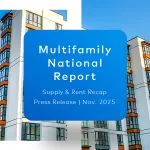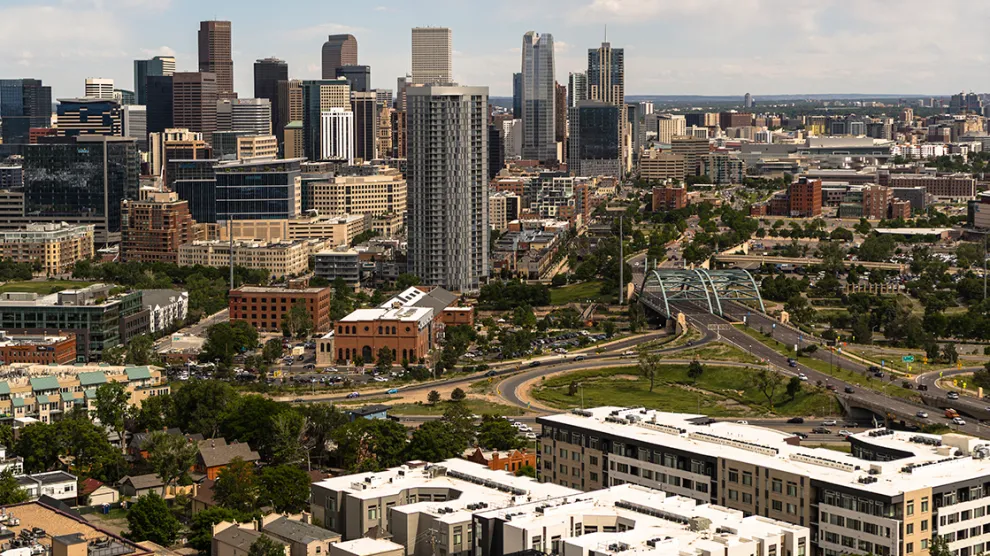On the back of four consecutive months of negative rent movement, the multifamily market also registers the weakest yearly growth since 2021.
Highlights:
- The average U.S. advertised asking rent dropped $8 to $1,740 in November, still 0.2% up year-over-year.
- Rates dropped 50 basis points short-term, with all but one of Yardi Matrix’s top 30 markets recording rent declines.
- As the Opportunity Zone program becomes permanent, analysts believe more than 1 million units could debut in the next decade.
- SFR-BTR average advertised rents slid $10 to $2,185 in November, dropping 0.5% year-over-year.
Advertised annual rent growth hasn’t been this sluggish since 2021
The national multifamily market entered its fourth consecutive month of negative advertised rent growth. The average rate dropped $8 to $1,740 in November, however, still growing 0.2% year-over-year. Coastal and Midwest metros registered the highest increases, with New York leading the way (5.7%), followed by Chicago (3.8%) and the Twin Cities (3.2%), as well as San Francisco (2.6%). High-supply markets experienced rental deceleration, such as Austin (-5.0%), Phoenix and Denver (-4.1% each), Las Vegas (-2.1%) and Dallas (-2.0%).
National advertised rents slid 50 basis points month-over-month, with all but one of Yardi Matrix’s top 30 markets stagnating or recording short-term losses. Twin Cities’ rates went up 0.5% and Chicago’s stood unchanged at 0.0%, while all other metros experienced rent contractions. Notably, metros that had robust yearly rent growth suffered steep short-term declines, including New York (-1.2%) and New Jersey (-0.9%). Other markets with rent depression comprise Austin and Seattle (-1.0% each) and Denver (-0.9%).
The national occupancy rate clocked in at 94.7% in October, unchanged from last year. The index retained its resilience across markets such as Atlanta (0.9% growth year-over-year), the Twin Cities (0.5%), San Francisco and Phoenix (0.4% each). Several markets with elevated levels of new supply, such as Indianapolis (-0.5%), Washington, D.C. (-0.3%), as well as Detroit, New Jersey and Miami (-0.2% each), witnessed a decline in occupancy. What’s more, October’s absorption figures at a national level were the lowest in several years.
Permanent Opportunity Zones promise an investment and development boost
Introduced in 2017, the Opportunity Zone incentive program has attracted roughly $350 billion in investment, mostly from middle-market entities. However, that volume might increase as the bill is slated to become permanent, potentially attracting private investors. The permanent enshrinement will also modify the program, redrawing tracts and reducing qualifying thresholds by half. Moreover, analysts project about 1 million housing units to debut across the next decade. For reference, 600,000 apartments came online in OZs since 2018, with, according to the Economic Innovation Group, about half rising directly as a result of the incentive.
Single-family build-to-rent rates fell $10 to $2,185 in November, dropping 0.5% year-over-year. The rents also declined $28 since they peaked at $2,213 in July. Although a winter slowdown is to be expected, this November was quite different than previous years, when the month witnessed 1.4% increases. Midwest markets such as Twin Cities and Chicago (7.9% each) registered the steepest increases. Sun Belt metros continued posting negative rent growth, including Austin (-3.9%), Charleston (-3.8%) and Pensacola (-2.5%).
Read the full Yardi Matrix Multifamily National Market Report: November 2025.











Add Comment